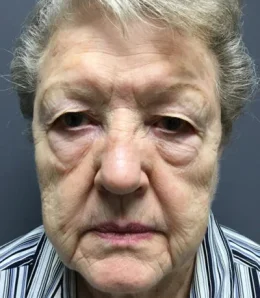There are many different types of machines used for laser skin resurfacing to treat aging skin issues. Some of these devices provide very little noticeable improvement. Other devices provide a result that varies greatly from one patient to another depending on their skin type. The CO2 (carbon dioxide) laser has been available since the late 1990s and is used by our plastic surgeon. It provides very reliable and predictable results for treatment of aging and sun-damaged skin.
What are the Benefits of CO2 Laser Skin Resurfacing?
CO2 laser skin resurfacing is a highly effective treatment for rejuvenating the skin and addressing a variety of concerns related to aging, sun damage, and texture irregularities. Using a precise carbon dioxide laser, this treatment removes damaged outer layers of the skin while stimulating collagen production in the deeper layers. The result is smoother, tighter, and more evenly toned skin. CO2 laser skin resurfacing can noticeably enhance:
- Fine lines and wrinkles, especially around the eyes and mouth
- Dullness
- Acne scars
- Enlarged pores
- Uneven pigmentation
- Rough texture
- Skin laxity
Since this skin rejuvenation treatment encourages long-term collagen remodeling, laser skin resurfacing not only improves the appearance of the skin but also helps maintain youthful firmness over time. Compared to other non-surgical treatments, CO2 laser resurfacing typically delivers more dramatic results in just one session, making it a popular option for those seeking strong improvement with minimal treatments.

Patient Results
Laser Skin Resurfacing Right for Me?
Ideal candidates for CO2 laser skin resurfacing are individuals looking to improve signs of aging, sun damage, or skin imperfections without undergoing traditional surgery. This procedure is best suited for people who have fair to medium skin tones and who have concerns such as fine lines, wrinkles, age spots, acne scars, or a dull, rough skin texture. It’s also important to have realistic expectations about the healing process and outcomes. While results can be transformative, there is a recovery period involving redness, peeling, and sun sensitivity. A consultation with Dr. Shaw is essential to determining if CO2 laser resurfacing is appropriate based on your skin type, goals, and medical history.
One key to getting safe, reliable results is to not over-do treatment. If the laser is used too aggressively, excessive redness, uneven pigment, and uneven scarring are possible. It’s best not to be too aggressive in one treatment. A second treatment can always be done later if greater change is desired.
Another key is patient selection. For skin that is more darkly pigmented, this type of laser skin resurfacing is not a good option. The risk of creating uneven pigment problems is increased. Best results are seen with lighter skin types — these are also the patients who typically have accumulated the most sun damage throughout their lifetimes.
Laser Skin Resurfacing Surgery
Although there is no cutting or incisions, this is a surgical procedure performed by Dr. James M. Shaw. General anesthesia is best for treatment of the entire face. Laser resurfacing of smaller treatment areas can be performed under IV sedation. The laser will strip away the epidermis or the outer layer of dry skin, and then shrink the next layer. Initially, the face is red and swollen with some fluid seeping. Ointment is applied until the new outer layer of skin grows back, which is usually five or six days. Once the new skin has healed, sunscreen and makeup can be applied. This treated area will be pink and this will lighten over the next three to six weeks.
You will want to gently wash your face two or three times a day after laser resurfacing. Ointment can be applied as often as necessary to keep the skin surface from becoming too dry. Itching can be bothersome at night. Benadryl can be very helpful to ease the itching and may be a bit sedating at night.
CO2 Resurfacing vs. Fractional Laser Resurfacing
A fractional CO2 laser provides a less aggressive, partial treatment of the skin. This allows for less tightening and improvement, but with a faster recovery. Patients are often disappointed with the results of the fractional CO2 laser on the face — it cannot compare to the traditional CO2 laser treatment.
However, some areas of the skin cannot be treated with the traditional CO2 laser — such as the neck, upper chest, and the back of the hands. The fractional CO2 laser can be a good option in places where the skin is thin, although multiple treatment sessions may be required.
How Long Do Laser Skin Resurfacing Results Last?
The results of CO2 laser skin resurfacing are long-lasting and can often be seen for several years after treatment, especially when combined with high-quality skin care products and sun protection. Most patients enjoy noticeably smoother, firmer, and more radiant skin for 3 to 5 years or longer depending on aging, lifestyle habits, and environmental exposure.
While the treatment significantly improves skin quality and reduces signs of aging, it does not stop the natural aging process. Therefore, some gradual return of fine lines and/or pigmentation can occur over time. However, many patients find that a single CO2 laser treatment provides benefits that outlast other non-invasive skin rejuvenation options. Maintenance treatments may be performed every few years if desired, and combining CO2 resurfacing with other treatments like microneedling, injectables, fillers, or medical-grade skincare can help prolong and enhance the results.



